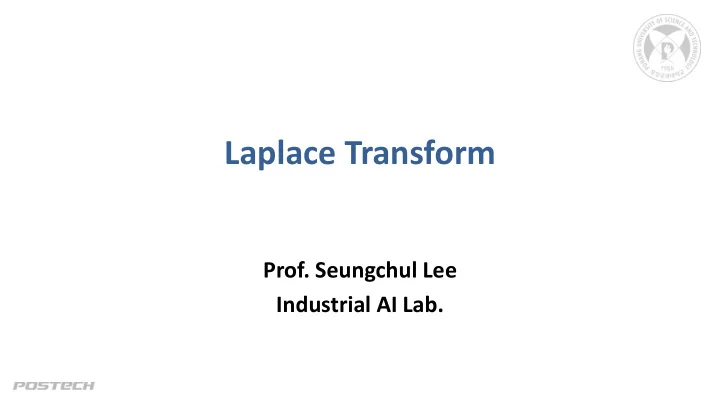

Laplace Transform Prof. Seungchul Lee Industrial AI Lab.
Two Famous Linear Transforms Fourier transform Laplace transform Pierre-Simon Laplace: Jean-Baptiste Joseph Fourier: 23 March 1749 – 5 March 1827) was a French scholar whose work was 21 March 1768 – 16 May 1830) was a French mathematician and important to the development of engineering, mathematics, statistics, physicist and best known for initiating the investigation of Fourier series, physics, astronomy, and philosophy. which eventually developed into Fourier analysis and harmonic analysis, and their applications to problems of heat transfer and vibrations. 2
Inner Product 3
Inner Product • For real valued vector • Orthogonal 4
Inner Product • Suppose 𝑐 𝑗 orthogonal basis 𝑦 can be represented (decomposed) with linear combinations of • Any Ԧ 𝑐 𝑗 • Question: How to find 𝑑 𝑗 ? • Meaning: 𝑑 𝑗 indicates how much 𝑐 𝑗 information contains in Ԧ 𝑦 5
Hermitian Transpose • Inner product for complex values • Want to know how much 𝑓 𝑘𝜕𝑢 component is contained in 𝑦(𝑢) 6
Two Linear Transformations Fourier Transform Laplace Transform 7
Laplace Transform 8
Laplace Transform • Want to know how much 𝑓 −𝜏+𝑘𝜕𝑢 = 𝑓 −𝜏 𝑓 𝑘𝜕𝑢 component is contained in 𝑦(𝑢) • Let 𝑡 = 𝜏 + 𝑘𝜕𝑢 9
Laplace Transform • The system output is given by • When 𝑦 𝑢 = 𝑓 𝑡𝑢 • We define the transfer function • We may write 10
Eigenfunction • If the output signal is a scalar multiple of the input signal, we refer to the signal as an eigenfunction and the multiplier as the eigenvalue • The eigenvalue associated with eigenfunction 𝑓 𝑡𝑢 is 𝐼(𝑡) 11
Definition: Laplace Transform • Laplace transform maps a function of time 𝑢 to a function of 𝑡 (complex frequency) – The Laplace transform is similar to the Fourier transform. 12
Example 1 • Provided 𝑆𝑓 𝑡 + 1 > 0 which implies that 13
Example 2 14
Example 3 • Laplace transform of the impulse function • Sifting property – Multiplying 𝑔(𝑢) by 𝜀(𝑢) and integrating over 𝑢 sifts out 𝑔(0) • Remember the Laplace transform of the impulse function is 1 15
Unit Impulse Signal • The unit-impulse signal acts as a pulse with unit area but zero width • The unit-impulse function is represented by an arrow with the number 1 , which represents its area • It has two seemingly contradictory properties : – It is nonzero only at 𝑢 = 0 and – Its definite integral (−∞, ∞) is 1 16
Laplace Transform of Unit-Impulse Signal • Laplace transform of unit-impulse function 17
Unit Step Signal • The indefinite integral of the unit-impulse is the unit-step • Laplace transform of unit-step function 18
Convolution Property of Laplace Transform • Suppose • Then • Convolution in time ↔ multiplication in s-domain 19
Convolution Property of Laplace Transform • Change of variables 20
Response to General Input • Response to LTI system with impulse response ℎ(𝑢) 21
Laplace Transform of a Derivative • Find the Laplace transform of 𝑧 𝑢 = ሶ 𝑦(𝑢) , given 22
Laplace Transform of a Derivative • Find the Laplace transform of 𝑧 𝑢 = ሶ 𝑦(𝑢) , given 23
Solving Differential Equations with Laplace Transform • Example of the first ODE • Laplace transform • This is a simple algebraic expression • Laplace transform converts a differential equation to an equivalent algebraic equation 24
Solving Differential Equations with Laplace Transform • Example of the second ODE 25
Laplace Transform of Integral • Laplace transform of integral 26
Laplace Transform of Integral • Laplace transform of integral 27
Transfer Function • Transfer function of an LTI system is defined as the Laplace transform of the impulse response. • Describe input-output behavior of the system. 28
Rational Transfer Function • Example 29
Transfer Function • Transfer function of differential equation system 30
Poles and Zeros • The poles and zeros of a rational transfer function offer much insight into LTI system characteristics • Determine the frequency response from poles and zeros (will discuss later) – Transfer function by substituting 𝑘𝜕 for 𝑡 – Evaluating the transfer function along the 𝑘𝜕 -axis in the 𝑡 -plane – Graphical evaluation or Bode plot 31
Recommend
More recommend